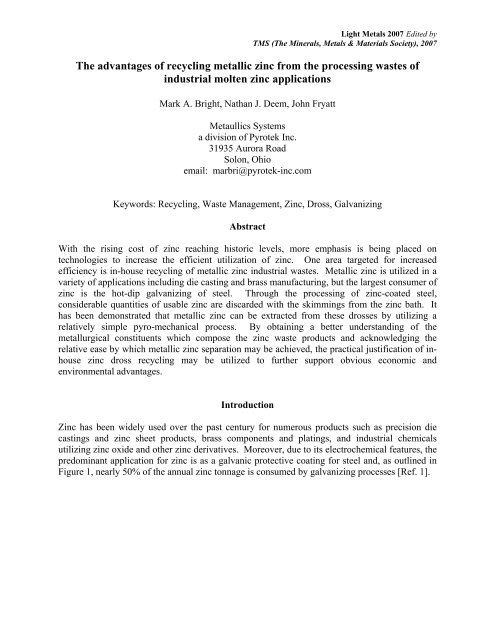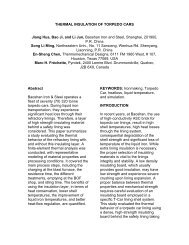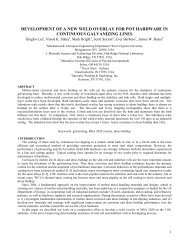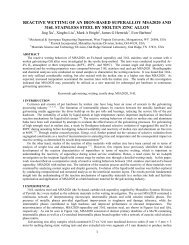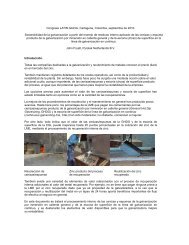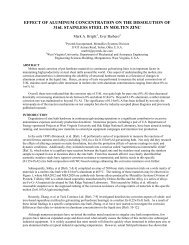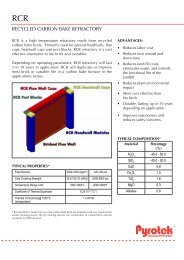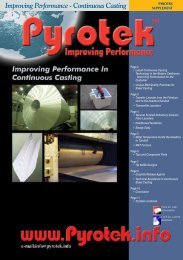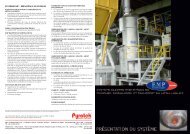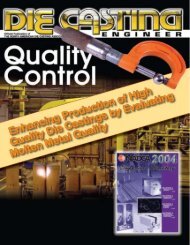The advantages of recycling metallic zinc from the ... - Pyrotek
The advantages of recycling metallic zinc from the ... - Pyrotek
The advantages of recycling metallic zinc from the ... - Pyrotek
Create successful ePaper yourself
Turn your PDF publications into a flip-book with our unique Google optimized e-Paper software.
Light Metals 2007 Edited by<br />
TMS (<strong>The</strong> Minerals, Metals & Materials Society), 2007<br />
<strong>The</strong> <strong>advantages</strong> <strong>of</strong> <strong>recycling</strong> <strong>metallic</strong> <strong>zinc</strong> <strong>from</strong> <strong>the</strong> processing wastes <strong>of</strong><br />
industrial molten <strong>zinc</strong> applications<br />
Mark A. Bright, Nathan J. Deem, John Fryatt<br />
Metaullics Systems<br />
a division <strong>of</strong> <strong>Pyrotek</strong> Inc.<br />
31935 Aurora Road<br />
Solon, Ohio<br />
email: marbri@pyrotek-inc.com<br />
Keywords: Recycling, Waste Management, Zinc, Dross, Galvanizing<br />
Abstract<br />
With <strong>the</strong> rising cost <strong>of</strong> <strong>zinc</strong> reaching historic levels, more emphasis is being placed on<br />
technologies to increase <strong>the</strong> efficient utilization <strong>of</strong> <strong>zinc</strong>. One area targeted for increased<br />
efficiency is in-house <strong>recycling</strong> <strong>of</strong> <strong>metallic</strong> <strong>zinc</strong> industrial wastes. Metallic <strong>zinc</strong> is utilized in a<br />
variety <strong>of</strong> applications including die casting and brass manufacturing, but <strong>the</strong> largest consumer <strong>of</strong><br />
<strong>zinc</strong> is <strong>the</strong> hot-dip galvanizing <strong>of</strong> steel. Through <strong>the</strong> processing <strong>of</strong> <strong>zinc</strong>-coated steel,<br />
considerable quantities <strong>of</strong> usable <strong>zinc</strong> are discarded with <strong>the</strong> skimmings <strong>from</strong> <strong>the</strong> <strong>zinc</strong> bath. It<br />
has been demonstrated that <strong>metallic</strong> <strong>zinc</strong> can be extracted <strong>from</strong> <strong>the</strong>se drosses by utilizing a<br />
relatively simple pyro-mechanical process. By obtaining a better understanding <strong>of</strong> <strong>the</strong><br />
metallurgical constituents which compose <strong>the</strong> <strong>zinc</strong> waste products and acknowledging <strong>the</strong><br />
relative ease by which <strong>metallic</strong> <strong>zinc</strong> separation may be achieved, <strong>the</strong> practical justification <strong>of</strong> inhouse<br />
<strong>zinc</strong> dross <strong>recycling</strong> may be utilized to fur<strong>the</strong>r support obvious economic and<br />
environmental <strong>advantages</strong>.<br />
Introduction<br />
Zinc has been widely used over <strong>the</strong> past century for numerous products such as precision die<br />
castings and <strong>zinc</strong> sheet products, brass components and platings, and industrial chemicals<br />
utilizing <strong>zinc</strong> oxide and o<strong>the</strong>r <strong>zinc</strong> derivatives. Moreover, due to its electrochemical features, <strong>the</strong><br />
predominant application for <strong>zinc</strong> is as a galvanic protective coating for steel and, as outlined in<br />
Figure 1, nearly 50% <strong>of</strong> <strong>the</strong> annual <strong>zinc</strong> tonnage is consumed by galvanizing processes [Ref. 1].
Sheet, 7%<br />
Die Casting,<br />
17%<br />
Miscellaneous,<br />
4%<br />
Chemicals, 7%<br />
Brass, 18%<br />
Galvanizing, 47%<br />
FIGURE 1: End-Use Zinc Consumption Distribution [Ref. 1]<br />
Over <strong>the</strong> past fifty years <strong>the</strong> production <strong>of</strong> <strong>metallic</strong> <strong>zinc</strong> has increased by over three times [Ref.<br />
2] with consumption levels now exceeding 7 million tonnes annually [Ref. 3]. However, due to<br />
this increasing demand as well as numerous o<strong>the</strong>r economic issues, <strong>the</strong> production supply <strong>of</strong><br />
primary <strong>zinc</strong> has been unable to keep pace with required <strong>zinc</strong> tonnage. As shown in Figure 2, <strong>the</strong><br />
demand for primary <strong>zinc</strong> has steadily grown over <strong>the</strong> past five years, but <strong>the</strong> <strong>zinc</strong> supply has been<br />
both erratic and diminishing. In addition it is widely accepted that this deficit in <strong>zinc</strong> production<br />
will not subside until mid-2007 or beyond [Refs. 1, 3-6]. At present <strong>the</strong> scarcity <strong>of</strong> <strong>zinc</strong> is<br />
making many <strong>zinc</strong> consumers invest in secured <strong>zinc</strong> supply just to avoid a potential interruption<br />
in raw material.<br />
Western Market Zinc Supply and Demand (Mt/yr)<br />
8.0<br />
7.5<br />
7.0<br />
6.5<br />
6.0<br />
5.5<br />
5.0<br />
Jan-99<br />
Jan-00<br />
Jan-01<br />
Jan-02<br />
Jan-03<br />
Jan-04<br />
Jan-05<br />
Jan-06<br />
Jan-07<br />
Demand<br />
Supply<br />
FIGURE 2: Zinc Supply and Demand Trends with Projections for 2007 [Ref. 3]
Consequently, <strong>the</strong> negative impact that has developed as a result <strong>of</strong> <strong>the</strong> depleted <strong>zinc</strong> production<br />
has been a sharp rise in primary <strong>zinc</strong> prices. Over a twelve month period <strong>from</strong> May 2005 to May<br />
2006 (Figure 3), <strong>zinc</strong> prices rose at an unprecedented pace <strong>from</strong> US$0.565/lb. to US$1.625/lb.<br />
In addition, <strong>the</strong>se LME cash prices did not reflect surcharges, delivery fees and o<strong>the</strong>r “extras”<br />
imposed by <strong>the</strong> <strong>zinc</strong> producers.<br />
LME Cash Price (US$/Tonne)<br />
$4,000<br />
$3,500<br />
$3,000<br />
$2,500<br />
$2,000<br />
$1,500<br />
$1,000<br />
$500<br />
$0<br />
January-05<br />
March-05<br />
May-05<br />
July-05<br />
September-05<br />
November-05<br />
FIGURE 3: LME Cash Price for Zinc and Hot-Dipped Galvanized Steel (HDG) [Ref. 7 & 8]<br />
Meanwhile, as <strong>the</strong> costs <strong>of</strong> <strong>zinc</strong> were rising rapidly, galvanized steel producers tried to maintain<br />
analogous price increases for <strong>the</strong> finished hot-dip galvanized sheet steel (Figure 3), however, <strong>the</strong><br />
cost differential still impacted <strong>the</strong> bottom line for many producers. “Zinc is now reported to<br />
account for 25% to 30% <strong>of</strong> <strong>the</strong> cost <strong>of</strong> HDG steel, as compared to around 5% before <strong>the</strong> price <strong>of</strong><br />
<strong>zinc</strong> headed skywards [Ref. 5].” Hence, steel companies must now start to consider alternative<br />
technologies for minimizing <strong>the</strong>ir <strong>zinc</strong> consumption such as tighter coating weight control and<br />
<strong>recycling</strong> <strong>of</strong> <strong>metallic</strong> <strong>zinc</strong> waste materials.<br />
January-06<br />
March-06<br />
Zinc Recycling<br />
Zinc, like most o<strong>the</strong>r metals, is easily recycled and approximately 30% <strong>of</strong> <strong>the</strong> overall <strong>zinc</strong><br />
consumption is currently <strong>from</strong> secondary sources [Ref. 2]. Many <strong>zinc</strong>-based products can<br />
reintroduce scrap components back into <strong>the</strong> production process with little variation. Brass scrap<br />
and <strong>zinc</strong> die castings can be directly remelted and recast as new parts much in <strong>the</strong> same manner<br />
as aluminum and iron castings. However, <strong>zinc</strong>-coated steel scrap and galvanizing process wastes<br />
are not as readily returned to <strong>the</strong> manufacturing process flow. In 1996, it was reported [Ref. 2]<br />
that <strong>the</strong> utilization <strong>of</strong> secondary <strong>zinc</strong> ingot by galvanizing facilities equated to less than 40% <strong>of</strong><br />
<strong>the</strong> tonnage <strong>of</strong> <strong>the</strong> <strong>zinc</strong> scrap, drosses, residues and wastes produced by <strong>the</strong> coating process.<br />
May-06<br />
July-06<br />
September-06<br />
Zinc<br />
HDG
Galvanized steel that has been ei<strong>the</strong>r scrapped or recycled is typically just remelted through a<br />
specialized system (quite prevalent in Electric Arc Furnaces) and <strong>the</strong> mill dust and volatized<br />
galvanized coating ash are collected and stored. <strong>The</strong> <strong>zinc</strong> content <strong>of</strong> this mill dust has been<br />
measured to be greater than 20wt% Zn [Ref. 9]. Although a significant amount <strong>of</strong> research has<br />
been devoted toward converting this <strong>zinc</strong>-rich ash into a functional product, <strong>the</strong> results have been<br />
mixed and a consistent, economically viable process has not been widely utilized. On <strong>the</strong> o<strong>the</strong>r<br />
hand, it has been proven that <strong>metallic</strong> <strong>zinc</strong> may be recovered <strong>from</strong> unpainted galvanized steel<br />
using a dedicated electrochemical process [Ref. 10] and <strong>the</strong> practicality <strong>of</strong> <strong>the</strong>se procedures is<br />
now being realized. Thus, only a minimal quantity <strong>of</strong> <strong>metallic</strong> <strong>zinc</strong> is currently recycled <strong>from</strong><br />
galvanized steel substrates.<br />
Conversely, <strong>the</strong> largest source <strong>of</strong> <strong>zinc</strong> waste for galvanizing plants is <strong>zinc</strong> drosses and residues<br />
<strong>from</strong> <strong>the</strong> molten galvanizing bath. Dross forms as a result <strong>of</strong> ei<strong>the</strong>r oxidation <strong>of</strong> <strong>the</strong> <strong>zinc</strong> at <strong>the</strong><br />
bath surface or by inter<strong>metallic</strong> reactions with <strong>the</strong> iron in <strong>the</strong> bath that has been introduced by <strong>the</strong><br />
steel substrates being coated. In <strong>the</strong> two typical categories <strong>of</strong> galvanizing, “general (or batch)<br />
galvanizing” and “continuous galvanizing (CGL)”, <strong>the</strong> <strong>zinc</strong> baths possess variable amounts <strong>of</strong><br />
aluminum (0-0.05wt%Al: General & 0.12-0.3wt%Al: Continuous) resulting in different dross<br />
compounds being formed. Looking at <strong>the</strong> <strong>zinc</strong>-rich corner <strong>of</strong> <strong>the</strong> Zn-Fe-Al phase diagram<br />
[Figure 4], <strong>the</strong> Fe solubility and subsequent dross compounds can be observed for each <strong>of</strong> <strong>the</strong><br />
galvanizing regimes.<br />
Iron (wt%)<br />
0.08<br />
0.07<br />
0.06<br />
0.05<br />
0.04<br />
0.03<br />
0.02<br />
0.01<br />
L + ξ<br />
L<br />
L + δ<br />
0<br />
0 0.02 0.04 0.06 0.08 0.1 0.12 0.14 0.16 0.180.2 0.22 0.24<br />
Aluminum (wt%)<br />
L + η<br />
465°C<br />
FIGURE 4: Zinc-Rich Corner <strong>of</strong> Zn-Fe-Al Ternary Phase Diagram at 465°C [Ref. 11]<br />
By analysis [Refs. 12, 13, 14] <strong>the</strong> floating “top” drosses (also known as “ash” or “skimmings”)<br />
for general galvanizing consist primarily <strong>of</strong> ZnO with varying amounts <strong>of</strong> Zn5(OH)8Cl2 while <strong>the</strong><br />
dross on <strong>the</strong> bottom <strong>of</strong> <strong>the</strong> kettle is FeZn13 (ξ) [Ref. 15]. Analogously, <strong>the</strong> top dross in<br />
continuous galvanizing is Fe2Al5 (η) and <strong>the</strong> bottom dross is FeZn10 (δ) [Refs. 11, 15]. However,<br />
during typical cleaning procedures to remove <strong>the</strong> accumulation <strong>of</strong> <strong>the</strong>se drosses, a tremendous<br />
amount <strong>of</strong> “clean” <strong>metallic</strong> <strong>zinc</strong> is also extracted <strong>from</strong> <strong>the</strong> galvanizing pots. General galvanizing<br />
dross can contain between 40% to 80% <strong>metallic</strong> <strong>zinc</strong> [Refs. 12, 13, 14] while CGL dross may<br />
contain up to 95% usable <strong>zinc</strong> [Ref. 14]. In 2003, DuBois [Ref. 16] noted that CGL drosses
contain minimal amounts <strong>of</strong> oxide particles (
FIGURE 5: Metaullics MZR Zinc Recovery System [Ref. 19]<br />
FIGURE 6: Pouring Recovered Zinc <strong>from</strong> a MZR System [Ref. 20]
As one example <strong>of</strong> <strong>the</strong> <strong>zinc</strong> chemistry effects in <strong>the</strong> MZR, Table 1 provides an outline <strong>of</strong> <strong>the</strong> ICP<br />
(Inductively Coupled Plasma) analysis <strong>of</strong> a representative processing run. Approximately<br />
550kgs. (1210 lbs.) <strong>of</strong> top dross (skimmings) <strong>from</strong> a general galvanizing pot were heated for 3<br />
hours with over 400kgs. (880 lbs.) <strong>metallic</strong> <strong>zinc</strong> extracted, resulting in a metal recovery in excess<br />
<strong>of</strong> 70%. Fur<strong>the</strong>rmore, <strong>the</strong> <strong>zinc</strong> purity <strong>of</strong> <strong>the</strong> recovered metal was >99.6wt% Zn and was<br />
analogous to <strong>the</strong> chemistry <strong>of</strong> <strong>the</strong> production galvanizing bath. Previous research [Ref. 21] has<br />
indicated that controlled usage <strong>of</strong> secondary recycled <strong>zinc</strong> ingot in galvanizing operations can<br />
provide a functional enhancement to primary <strong>zinc</strong> supply. Moreover, <strong>the</strong> <strong>zinc</strong>-depleted ash<br />
(“residual ash”) <strong>from</strong> <strong>the</strong> MZR processing was still viable for sale at a reasonable rate due to <strong>the</strong><br />
induced purity <strong>of</strong> <strong>the</strong> retained ZnO and residual elemental Zn content.<br />
TABLE 1: Identification <strong>of</strong> Zinc Chemistry for Input and<br />
Output Products <strong>from</strong> a MZR System [Ref. 20]<br />
Dross<br />
Recovered<br />
Metallic Residual<br />
Analysis Zinc Ash<br />
Zn: 87.37 99.66 74.86<br />
Fe: 0.61 0.316 0.637<br />
Al: 1.33 0.001 1.99<br />
Si: 0.21
Conclusions<br />
• Rising primary <strong>zinc</strong> prices have reached historic levels and are greatly impacting <strong>the</strong> raw<br />
material costs <strong>of</strong> <strong>zinc</strong> consuming industries such as galvanizing, die casting and brass<br />
manufacturing.<br />
• <strong>The</strong> quantity <strong>of</strong> <strong>metallic</strong> <strong>zinc</strong> contained within <strong>the</strong> waste materials <strong>of</strong> <strong>the</strong>se <strong>zinc</strong> processing<br />
facilities is extremely high, especially for producers <strong>of</strong> galvanized steel products.<br />
• <strong>The</strong> <strong>metallic</strong> <strong>zinc</strong> content <strong>of</strong> <strong>the</strong> waste drosses which are discarded <strong>from</strong> a molten <strong>zinc</strong> pot in a<br />
galvanizing operation may exceed 90%.<br />
• Unlike die casting and brass manufacturing, currently only a minimal volume <strong>of</strong> recycled <strong>zinc</strong><br />
is directly returned to an industrial galvanizing pot.<br />
• Implementation <strong>of</strong> defined in-house procedures by galvanizing operations could help extract<br />
higher fractions <strong>of</strong> valuable <strong>zinc</strong> <strong>from</strong> <strong>the</strong>ir process wastes.<br />
• Utilization <strong>of</strong> a Metaullics MZR Zinc Recovery System may enhance retention <strong>of</strong> <strong>zinc</strong><br />
inventories by providing an on-site secondary processing technique for recovery <strong>of</strong> usable<br />
<strong>metallic</strong> <strong>zinc</strong>.
References:<br />
1. Smale, D., “Zinc in galvanizing: a world view, with special reference to China”,<br />
Intergalva2006 Conference, Naples, Italy, June 2006<br />
2. Zinc Recycling: <strong>The</strong> General Picture, 1996, International Zinc Association<br />
3. Deller, G., “Zinc price forecasting – explaining <strong>the</strong> limitations”, Intergalva2006<br />
Conference, Naples, Italy, June 2006<br />
4. Schauman, M., “Outlook for <strong>zinc</strong> market: will supply meet growing demand?”, 11th<br />
International Galvanizing and Coil Coating Conference, Metal Bulletin, September 2006<br />
5. Platts Metals Daily LME Close Edition, September 21, 2006, McGraw-Hill Co.<br />
6. Market Analysis, Metal Bulletin Monthly, September 2006, issue 429, pp. 15<br />
7. MBR Coated Steels Monthly, August 2006, issue 91, Metal Bulletin<br />
8. London Metals Exchange, www.lme.com<br />
9. Lopez, F. A., Medina, F., Medina, J., Palacios, M. A., “Process for recovery <strong>of</strong> nonferrous<br />
metals <strong>from</strong> steel mill dusts involving pelletising and carbo<strong>the</strong>rmic reduction”,<br />
1991, Ironmaking and Steelmaking, vol. 18, no. 4, pp. 292 – 295<br />
10. Everitt, M., “Pr<strong>of</strong>itable <strong>recycling</strong> <strong>of</strong> galvanized scrap”, 11th International Galvanizing<br />
and Coil Coating Conference, Metal Bulletin, September 2006<br />
11. Shastry, C. R., Galka, J. J., “Analysis <strong>of</strong> <strong>zinc</strong> melt for aluminum, iron and dross<br />
inter<strong>metallic</strong>s”, Galvanizer’s Association Annual Meeting, 1998, Indianapolis, Indiana<br />
12. Barakat, M. A., “Recovery <strong>of</strong> <strong>zinc</strong> <strong>from</strong> <strong>zinc</strong> ash and flue dust by pyrometallurgical<br />
processing”, Recycling <strong>of</strong> Metals and Engineered Materials, 2000, TMS, pp. 211 – 223<br />
13. Barakat, M. A., “<strong>The</strong> pyrometallurgical processing <strong>of</strong> galvanizing <strong>zinc</strong> ash and flue<br />
dust”, Journal <strong>of</strong> Metals, August 2003, TMS, pp. 26 – 29<br />
14. Unpublished research, Metaullics Systems (div. <strong>of</strong> <strong>Pyrotek</strong> Inc.), Solon, Ohio 2004-2006<br />
15. Marder, A. R., “<strong>The</strong> metallurgy <strong>of</strong> <strong>zinc</strong>-coated steel”, Progress in Materials Science,<br />
2000, vol. 45<br />
16. DuBois, M., “Top drosses: <strong>the</strong> undocumented gold mine”, Galvanizer’s Association<br />
Annual Meeting, 2003, Monterrey, Mexico<br />
17. Davies, J., Galvanized Iron: Its Manufacture and Uses, 1914, Spon and Chamberlain, pp.<br />
99 - 101<br />
18. Daesen, J. R., Galvanizing Handbook, 1946, Reinhold Publishing, pp. 133 – 136<br />
19. Fryatt, J., Vanska, J., “In-house recovery <strong>of</strong> <strong>metallic</strong> <strong>zinc</strong> and o<strong>the</strong>r metals <strong>from</strong><br />
continuous process drosses and residues”, 11th International Galvanizing and Coil<br />
Coating Conference, Metal Bulletin, September 2006<br />
20. Deem, N., “In-house recovery <strong>of</strong> <strong>metallic</strong> <strong>zinc</strong> <strong>from</strong> galvanizing bath skimmings”, AGA<br />
TechForum Conference, American Galvanizers Association, October 5-7, 2005<br />
21. Shastry, C. R., Galka, J. J., “A comparative evaluation <strong>of</strong> jumbo ingots produced <strong>from</strong><br />
primary <strong>zinc</strong> and <strong>from</strong> <strong>zinc</strong> recovered <strong>from</strong> dross”, Galvanizer’s Association Annual<br />
Meeting, 2000, Toronto, Ontario


